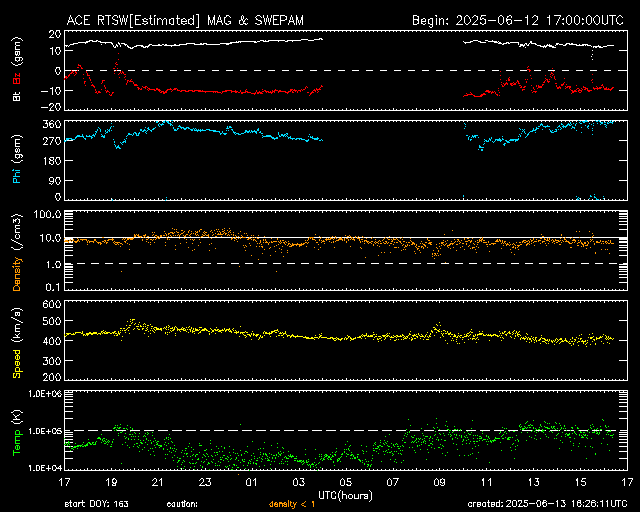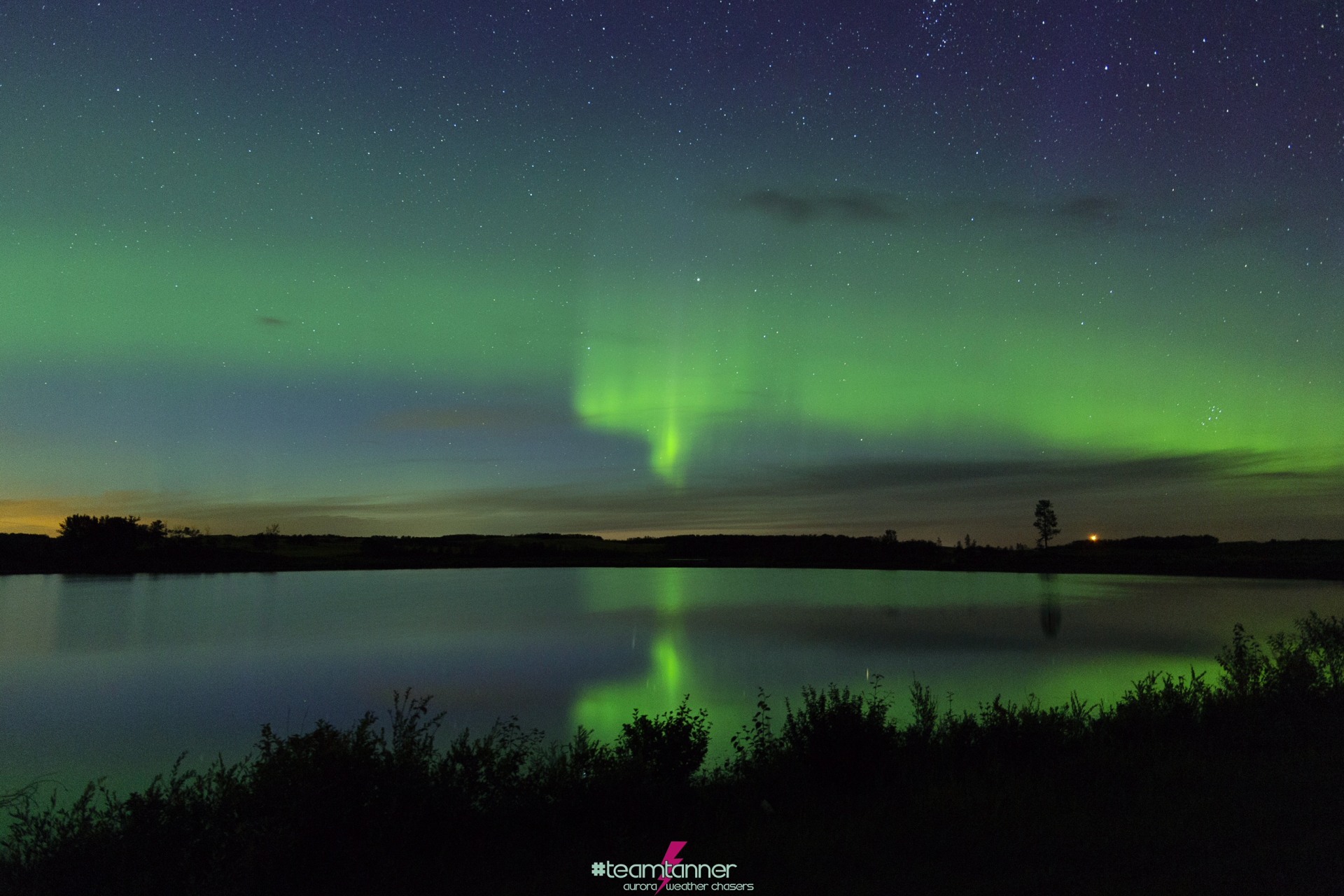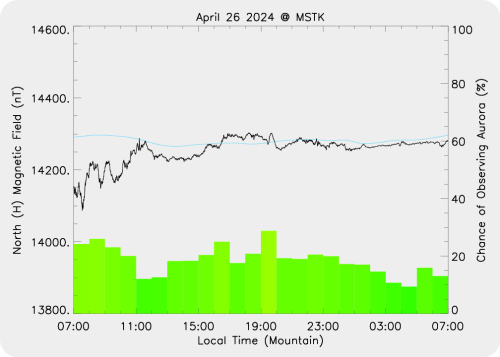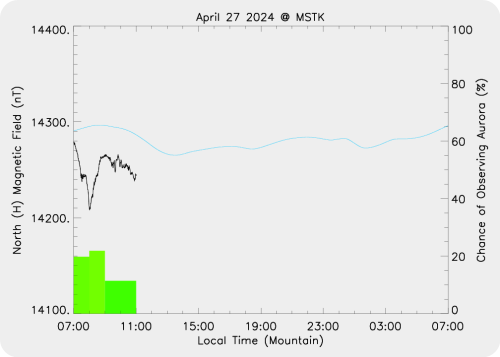This website provides a real-time monitor of geomagnetic activity in the Edmonton area (though larger activity can be seen Alberta-wide). Join over 100,000 people using our free email alert service to know if there may be aurora visible tonight. The current probability of witnessing an aurora tonight is: 
| 14%
| Current geomagnetic activity plots for the Edmonton region (and similar magnetic latitudes). Yesterdays information can be seen on the left, todays on the right. (Click on the image to enlarge).
|
|
This years DASP conference and workshop will be taking place in Edmonton, Feb 20–23, 2024. For more information, please visit https://dasp.spacephysics.ca. |
|
There was a very weak CME impact yesterday, that caused very weak Aurora near dawn, but not the large impact expected from the emission on Thursday. The disturbance was not enough to trigger and Aurorawatch alert. Conditions may remain disturbed for this evening leading to a slightly elevated chance, but unlikely to be the big storm we were expecting. So it looks like no treat for us this Halloween after all...
|
|
|
 The solar wind (particles that constantly stream outward from the sun) has a typical speed of 400 km/s. A coronal mass ejection (CME—the emission from the sun that causes Aurora) typically has a speed of 1000-2000 km/s.
The solar wind (particles that constantly stream outward from the sun) has a typical speed of 400 km/s. A coronal mass ejection (CME—the emission from the sun that causes Aurora) typically has a speed of 1000-2000 km/s.
The ACE satellite sits 1.4M km sunward from Earth, measuring the solar wind speed. You can see the data here: ACE SWEPAM DATA. The yellow trace shows the current solar wind speed and when this rapidly increases well above 400 km/s then the CME is 15 minutes away! |
|
|
 Potentially good viewing for Halloween 2021. A coronal mass ejection that occurred on Thursday (Oct 28, 2021) is heading Earthward and should arrive at some time on Saturday. This increases the chances of seeing Aurora for Saturday, Sunday and possibly Monday.
Potentially good viewing for Halloween 2021. A coronal mass ejection that occurred on Thursday (Oct 28, 2021) is heading Earthward and should arrive at some time on Saturday. This increases the chances of seeing Aurora for Saturday, Sunday and possibly Monday.
Weather conditions, as of the Friday, are favourable, with clear skies forecast.
|
|
|
 There is a potential for increased activity tonight and for the next couple of days due to an inbound coronal mass ejection that accompanied a solar flare. A solar flare is a release of energy on the sun due to a rapid reconfiguration of the magnetic field near sunspots. This burst of energy (radiation) occurs across all wavelengths. A coronal mass ejection is an emission of plasma from the sun. It is these particles that will eventually reach the Earth and potentially 'rain-down' into the upper atmosphere treating everyone to a show.
There is a potential for increased activity tonight and for the next couple of days due to an inbound coronal mass ejection that accompanied a solar flare. A solar flare is a release of energy on the sun due to a rapid reconfiguration of the magnetic field near sunspots. This burst of energy (radiation) occurs across all wavelengths. A coronal mass ejection is an emission of plasma from the sun. It is these particles that will eventually reach the Earth and potentially 'rain-down' into the upper atmosphere treating everyone to a show.
The weather forecast for the next few days suggest little cloud (though the weather forecasts at the moment are less accurate!) providing clearer skies. See the Environment Canada cloud forecast.
Upstream conditions are measured by a satellite called ACE, sitting between the Earth and the Sun (orbiting the L1 point): https://services.swpc.noaa.gov/images/ace-mag-swepam-6-hour.gif For a good display we would like to see the particle density and speed increase increase (indicating the CME has arrived), together with a Bz being negative (indicating the interplanetary magnetic field is pointing south). This would give the best conditions to let the particles to get into the Earth's magnetic field (the magnetosphere).
The good news for aurora watchers is that these particles can disrupt the magnetic field of the Earth enabling trapped particles to also 'rain-down' for a couple of days. So if you don't get chance to see anything tonight, you might stand a chance tomorrow too! |
|
 Despite being a very quiet July, the aurora did make a little show...
Thanks go to and D and T Tanner.
Despite being a very quiet July, the aurora did make a little show...
Thanks go to and D and T Tanner.
|
|
Read more...
|
|
|
|












 Potentially good viewing for Halloween 2021. A coronal mass ejection that occurred on Thursday (Oct 28, 2021) is heading Earthward and should arrive at some time on Saturday. This increases the chances of seeing Aurora for Saturday, Sunday and possibly Monday.
Potentially good viewing for Halloween 2021. A coronal mass ejection that occurred on Thursday (Oct 28, 2021) is heading Earthward and should arrive at some time on Saturday. This increases the chances of seeing Aurora for Saturday, Sunday and possibly Monday.
 There is a potential for increased activity tonight and for the next couple of days due to an inbound coronal mass ejection that accompanied a solar flare. A solar flare is a release of energy on the sun due to a rapid reconfiguration of the magnetic field near sunspots. This burst of energy (radiation) occurs across all wavelengths. A coronal mass ejection is an emission of plasma from the sun. It is these particles that will eventually reach the Earth and potentially 'rain-down' into the upper atmosphere treating everyone to a show.
There is a potential for increased activity tonight and for the next couple of days due to an inbound coronal mass ejection that accompanied a solar flare. A solar flare is a release of energy on the sun due to a rapid reconfiguration of the magnetic field near sunspots. This burst of energy (radiation) occurs across all wavelengths. A coronal mass ejection is an emission of plasma from the sun. It is these particles that will eventually reach the Earth and potentially 'rain-down' into the upper atmosphere treating everyone to a show.

 Aurora Watch Website. Version 1.0.
Aurora Watch Website. Version 1.0.